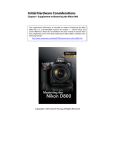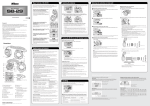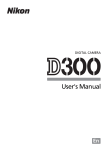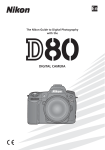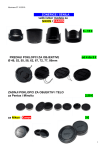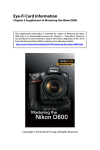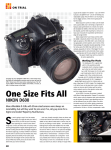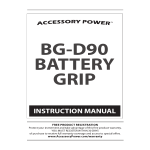Download Chapter 1 Supplement – Initial Hardware Considerations
Transcript
Initial Hardware Considerations Chapter 1 Supplement to Mastering the Nikon D300/D300S This supplemental information is intended for readers of Mastering the Nikon D300/D300S only. It is a downloadable resource for Chapter 1 – Basic Camera Setup. Please do not distribute this extra material to anyone other than a legitimate owner of the book. Mastering the Nikon D300/D300S is available at the following website: http://www.rockynook.com/books/158.html Copyright © 2011 Darrell Young, All Rights Reserved 2 If you’re like me, you’ll open your camera’s box, attach the lens, insert the battery, and take your first picture. Wouldn’t it be a better idea to wait an hour to charge the battery, and only then take the first picture? Sure it would, but I’ve never done that, and I bet you won’t either. Nikon knows this and doesn’t send out new cameras with dead batteries. Most of the time the battery is not fully charged, but it has enough power to set the time and date, then take and review a few pictures. Think about it. How would you test a brand new battery? You’d charge it and see if it will hold a charge. Do you think Nikon is in the habit of sending out batteries that are untested? No! So most of the time, you can play with your new camera for at least a few minutes before charging the battery. I’ve purchased nearly every DSLR Nikon has made since 2002, and not one of them has come with a dead battery. When my latest camera arrived, the battery was about 60 percent charged. I used the camera for an hour or two before I charged the battery. However, let me mention one important thing. If you insert the battery and its charge is very low, such as below 25 percent, it might be a good idea to go ahead and charge it before shooting and reviewing lots of pictures. You may be able to set the time and date, and test the camera a time or two, but go no further with a seriously low battery. Included in the box with the camera is the Nikon Quick Charger MH-18a. The battery will only fit on the charger in one direction, as shown in FIG 1A. An orange indicator light on the charger will blink until the battery is fully charged. When the blinking stops and the light stays orange, the battery is ready for use. FIG 1A – Charging the camera’s battery The camera uses a lithium-ion (Li-ion) battery pack. While this type of battery doesn’t develop the memory effects of the old nickel-cadmium (NiCad) batteries from years past, there can be a problem if you let them get too low. A Li- 3 ion battery should not be used to complete exhaustion. It has a special protection circuit that will disable the battery if one of the cells goes below a certain key voltage. You’d probably have to run it all the way down and then store it in the camera for a few weeks to actually cause the battery to disable itself. However, a good rule of thumb is this: When your camera’s Li-ion battery gets down to the 25 percent level, please recharge it. I don’t let mine go below 50 percent for any extended use. If you can hold yourself back from turning on the camera until after the battery is charged, that would be the optimum situation. That’ll give you some time to read more of this chapter, and even check out the User’s Manual. FIG 1B – Examining and inserting the battery FIG 1B shows how to insert the battery into your camera. On the left side of the image you can see the battery from the top and bottom. Notice that you insert the battery with the rounded side up and the flat side down. To the left of the word “Nikon” on the battery’s top is a small, faint arrowhead. Insert the battery in the direction of the little arrow, as shown in FIG 1B. In the picture, the little door on the bottom of the camera’s grip is open and the battery is partially inserted in the correct orientation. Push it all the way in and close the small battery cover. 4 FIG 1C – Battery info screen Please use only a Nikon brand EN-EL3e battery pack in your camera. This particular battery has a special circuit that talks to the camera and enables the Battery age (D300S) or Charging life (D300) scale shown on the Battery info screen (see FIG 1C). The name difference of this scale is just a textual change between the two cameras; the function is the same. It tells you when a battery has outlived its usefulness and should be disposed of—going beyond just telling you when it’s low on power. In FIG 1C you can see a picture of the Battery info screen. Notice that it shows the Bat. meter, which gives you the amount of voltage charge or power the battery has left as a percent value. The Pic. meter shows the number of images taken since this battery was last charged and inserted. Finally, the Battery age (D300S) or Charging life (D300) scale tells about the life of the battery and whether it needs to be replaced. It uses a scale of 0 – 4, or five steps of life. Once again, this scale has nothing to do with the amount of power that the battery currently contains. It shows how much useful life the battery has left until you need to recycle it and buy a new one. My Recommendation: A genuine, new Nikon EN-EL3e battery for the D300(S) is usually less than $50 USD when purchased online. Why buy a cheap aftermarket battery made who-knows-where and use it to power the circuits of your expensive camera? How can you be sure that a cheap non-Nikon battery even has the correct circuit for Battery info communication? How can you know that the cheap cells won’t short-circuit and burn your camera to a cinder? Li-ion cells are a bit finicky and require careful manufacture and charging control. Personally, I’ll only trust the real thing, a Nikon brand EN-EL3e battery, to power my expensive camera. 5 Attaching and Removing a Lens You may have purchased your camera as a kit, or just the body alone. From looking around on the Internet I see three camera kit combinations being offered currently: Nikon D300(S) and the AF-S Nikkor 16-85mm F3.5-5.6G VR Nikon D300(S) and the AF-S Nikkor 18-200mm F3.5-5.6G VR Nikon D300(S) body only Personally, I have several lenses, so I didn’t buy a kit version. In this book you’ll mostly see pictures of my D300S with the Nikkor 16-85mm lens. Just in case this is your first DSLR camera, I’m going to include a couple of pictures that show how to attach a lens. It seems hard the first time you do it, but after that it’s quite easy. One of the powerful things a DSLR like the D300(S) can do is use a variety of lenses to achieve various subject “looks” or perspectives. If you’ve never put a lens on a DSLR, please read this carefully so that you won’t damage the lens or camera body. FIG 2A – Remove the lens and body caps Nikon ships the camera without the lens attached. Instead there’s a body cap and lens cap that must be removed before you mount the lens to the camera body. In FIG 2A, you see the camera and lens out of their boxes but with both caps still attached (see red arrows). Leave the camera turned off while attaching or removing lenses. I’ve never damaged a camera’s electronics by leaving it on during lens changes, but there’s always a first time. Sometimes, in the heat of shooting and quickly changing lenses, I forget and just change it with the camera on, so it’s probably not too 6 dangerous. However, I may just have been fortunate. I don’t recommend that you take chances with an expensive camera or lens. Dust is bad! Blow away any dust you see on the front of the camera or on the rear of the lens so it won’t get inside the camera body and end up on the sensor. Dust can cause a spot on your pictures if it gets on the sensor, so always change lenses in a dustfree area when possible. Now, let’s remove the caps and prepare to attach the lens to the camera. FIG 2B – Caps have been removed To remove the camera’s body cap, press and hold the Lens Release button and turn the body cap clockwise until it stops; then pull the cap straight out. It uses a “bayonet” mount with three ears, just like a lens. The lens cap is similar in that you grasp the lens and turn the lens cap to the right, and then pull it off. Attaching the Lens It isn’t hard to attach the lens to the camera, and when you’ve done it once, you’ll have no problems in the future. So, let’s mount the lens. It attaches to the camera using a Nikon F bayonet-style mount that’s been in production for over 50 years. Nearly any lens ever made for a Nikon film SLR or DSLR will mount on your camera. The exception is non-AI manual focus lenses from the late 1960s and early 1970s. This type of lens can damage the camera’s aperture ring prong. 7 You are safe with virtually all Nikkor manual focus AI and AI-S lenses, plus the Nikkor autofocus AF and AF-S lenses. Let’s consider how to mount an AF-S Nikkor 16-85mm lens. FIG 2C – Mounting the lens on the camera step-by-step Notice in FIG 2C, image 1, how the lens has a white dot (A) that must line up exactly with a corresponding white dot (B) on the camera body. The lens must be inserted into the front of the camera until the two dots are close together, as in FIG 2C, image 2. Once the lens is full inserted into the bayonet mount and the dots are lined up, slowly turn the lens counterclockwise (rotate left) until the white dot on the lens is under the “K” of the Nikon logo on the front top of the camera. The dot on the lens will then be straight up and just below the Nikon logo, as in FIG 2C, image 3. Do not force the lens to turn. If it doesn’t turn easily to the left make sure that you’ve fully inserted the lens into the body before you start turning it toward the locking position. When you get the lens’s white dot in the up position (A is up), you’ll hear an audible “snap” as the lens locks to the body. To remove the lens in the future, hold in the Lens release button, turn the lens clockwise until it stops, and then pull it straight out. The Lens release button is the big D-shaped button to the right of the lens mount. Refer to the Camera Body Reference section at the beginning of this book for button locations on your specific camera. The steps to remove a lens are discussed next. Removing the Lens Here are the steps I use to remove and change a lens quickly, without dropping the camera or lens. Try this method and see if it works for you (see FIG 2D). If not, simply invent your own way of holding the camera while changing lenses. 8 FIG 2D – Removing the lens from the camera 1. Hold the camera body in your left hand with your fingers reaching around the front. You’ll be grasping it on the side that has no grip, and your fingers will cover the rubber Connector cover on the end. Your middle finger will naturally fall over the Lens release button. 2. Press the grip side of the camera into your body to stabilize it. The camera’s rear Monitor will be facing the left side of your body and the palm of your left hand. 3. Press and hold the Lens release button with the middle finger of your left hand. 4. Using your right hand, turn the lens clockwise until it stops, then pull it straight out of the camera body. If you’re a left-handed person, this method will still work. Our cameras are designed for right-handed people, so a “lefty” may find this awkward the first few times. I suggest you keep trying to learn it, since this method allows you to hold the camera and lens very securely while making lens changes. It would be a shame to drop and break either the lens or camera body. (Don’t ask me why I mentioned this!) If this list of steps doesn’t work for you, just set the camera down, press and hold the Lens release button, rotate the lens to the right, and pull it out of the body. 9 Lens Controls While examining the lens for later use, you’ll notice several controls that you’ll need to use (see FIG 3). Many AF-S Nikkor lenses, and even aftermarket lenses, have similar controls, although the names might vary slightly. FIG 3 – Lens zoom ring, focus ring, and switches FIG 3 shows the five numbered controls that we’ll discuss in our list: 1. Zoom Ring – This ring is the most used control on the lens. You’ll use it constantly to zoom in and out; from the widest to the longest focal length, and any point in between. On this lens, the 16mm setting is a wide-angle setting, which allows you to take group portraits or get sweeping landscape shots. The 85mm setting is a short telephoto position. Use the 85mm setting to pull a subject closer and fill the image frame. You can use the Zoom ring to select the exact focal length that you need to make the best image composition. As you turn the Zoom ring, you’ll see the numbers turn with it. The numbers shown on the lens in FIG 3 are 16, 24, 35, 50, 70, and 85. Each represents a focal length in millimeters (mm). Place any number from 16 to 85 next to the white dot on top of the lens for a focal length position. In between the numbers are other focal lengths. Let’s say you turned the lens to halfway between 16 and 24mm. That is about 20mm, as expected. It’s constantly variable as you turn the zoom ring. 2. Focus Ring – The Focus ring is not often used on a camera with autofocus, which is why it’s so small. However, for things like close-up 10 (macro) shots, it is sometimes easier to turn off the autofocus and focus manually so that you can control exactly where you want to place the sharpest point of focus. Study the section M/A - M switch (#3) before you use the Focus ring. On some lenses, the zoom and focus rings are reversed. 3. M/A - M Switch – Many Nikkor lenses have an M/A - M switch on the side. If you have a lens with a switch labeled M/A - M, it is safe to allow the camera to focus, and then fine-tune the focus with the Focus ring. The M/A setting is called “autofocus with manual override; manual priority” by Nikon, while the M setting is simply called “manual mode.” On some Nikon lenses you may find an A/M switch instead of the M/A - M switch. These lenses may or may not allow you to fine-tune the autofocus when in the A mode. Lower cost lenses usually won’t, while some of the very expensive Nikkors will allow manual override in autofocus mode. The way to be sure is to carefully attempt to turn the Focus ring, and if you feel resistance stop immediately. Basically, the M/A setting causes the camera to autofocus for you, but you can fine-tune the focus manually. The M setting is completely manual focus, and you are responsible for all focus operations. 4. VR On/Off Switch – VR stands for vibration reduction. Lenses with the VR moniker are able to compensate for small shaky movements while pictures are being taken handheld—potentially resulting in much sharper images. They have a special lens element that moves to compensate for small camera movements. I don’t mean you can wave your camera around like a fire hose and still get sharp images. What I mean is that the lens will try to compensate for natural hand shakiness. It allows you to use slower shutter speeds and still get sharp images. According to how shaky you are while handholding, you may take pictures with shutter speeds up to three or four stops slower, depending on the individual lens’s VR type. There are two types of VR lenses on the market currently: VR and VR II. The more advanced form of VR—called VR II—has algorithms that notice when the camera is very still, and disable VR. Why use vibration reduction when the camera isn’t vibrating? What about using VR on a tripod? Nikon says you should be okay when shooting on a tripod with VR II turned on. However, I always flip the switch to off anyway, unless I’m using a shaky tripod. The older style VR can cause some seriously weird effects when the camera is on a stable tripod. Check the specs of any new lens you buy to determine if it has standard VR or VR II. VR II adds an additional stop of 11 vibration reduction, so you could handhold up to four stops slower, instead of three. VR II is found on the more pricey lenses in the Nikkor lineup. An easy way to tell if you have VR or VR II is by how many extra slow stops you get. If the lens’s sales literature says three stops, it is VR. If four stops, it is VR II. 5. Normal/Active Switch – This setting is designed to allow your lens to compensate for different types of vibration when using the VR mode. It is primarily designed to allow you to shoot sharper images from a moving vehicle. So, any time you are in some way moving rapidly and want to take pictures, use the Active setting. The Normal setting is for everyday handheld images. Here’s a paragraph from a Nikon website describing why they created the Normal/Active lens setting: “The frequency of camera shake experienced during regular handheld shooting is different from that encountered when trying to shoot from a moving vehicle or vessel. We designed the VR function to be able to compensate for severe vibrations encountered when you're in a car, on a train or airplane, and even aboard a helicopter.” (Found at http://imaging.nikon.com) Note: On some lenses the Zoom and Focus rings are reversed. Many lenses have the Focus ring near the front of the lens, instead of near the camera body. Using Memory Cards The D300S and D300 have different memory card features. The D300S uses both a Compact Flash (CF) and a Secure Digital or Secure Digital High Capacity card (SD or SDHC). The D300 uses a Compact Flash memory card only. FIG 4 shows both cameras and how to insert the memory cards. FIG 4 – Inserting memory card(s) 12 The D300 has a little Pac-Man looking symbol and lever that allows you to open the memory card door. The D300S is designed so that you pull the memory card door toward you until it pops open. I like the style of the D300 door better than the D300S. I sometimes accidentally open the memory card door when pulling the D300S out of a camera bag. Adding the Lv and Info buttons to the back of the D300S took away the space needed for the door lever that’s used on the D300.












